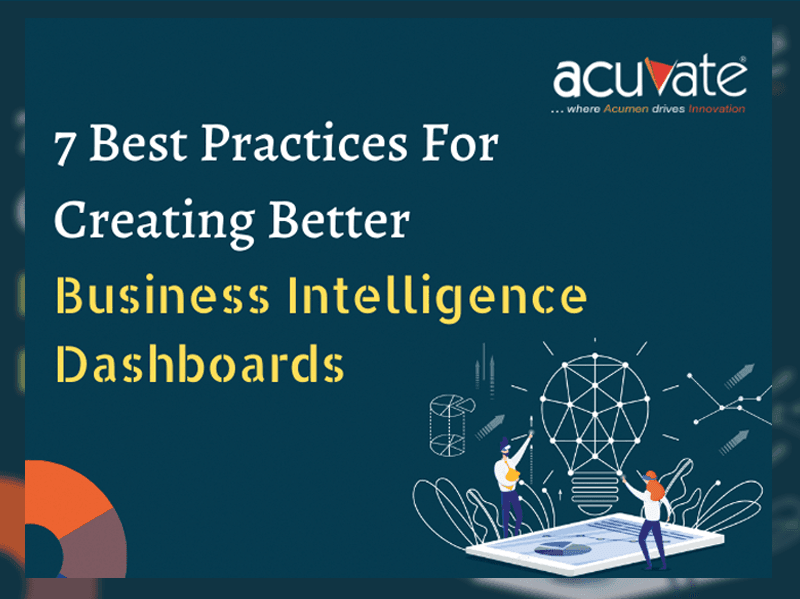According to a recent BARC study, data visualization is one of the 20 biggest BI trends of 2019. And the primary mode of delivery for data visualization is through the creation of Business Intelligence dashboards. BI dashboards are used to put together visualizations of complex raw data, making it easier for the user to get an overview of the most important information and process it at-a-glance.
Even if you have the most high-value data useful insights on hand, using a poorly designed dashboard can be detrimental to how the information is received and comprehended by the audience. Hence, even if you do not have a team of design experts for the building of BI dashboards, you can follow these best practices to ensure that your dashboards are easily comprehensible and functional for the end-user.
7 Best Practices for Creating Better BI Dashboards
1. Capture Your Reporting Requirements
When it comes to creating BI dashboards, understand that one size does not fit all. Your first step must be to establish ‘why’ you need to create a dashboard and define ‘who’ we will be using this data.
Establishing your target audience and stakeholders will help you develop reports with data that is highly relevant to their needs and expectations. Depending on the end-users’ technical skills, you must choose data visualization styles, dashboard types, and report formats that are the best fit. Identify their reporting requirements by conducting in-person or phone interviews. These interviews will also help you understand the right KPIs that need to be included.
2. Be Aware Of The Different Kinds Of Dashboards Available
Just as important as determining the ‘Why’ and ‘who’ behind creating the BI dashboard, is understanding all the different types of dashboards that you can create. So before the right dashboard design tool is selected, you must establish all the different types of traditional dashboards available and what kind of data each type is best used for.
The different types of traditional dashboards include:
- Strategic Dashboard – Used to aggregate data regarding the general health of the organization based on which the C-suite can make crucial decisions regarding organizational expansion.
- Analytical Dashboards – Used to provide an in-depth analysis of data trends with respect to time
- Operational Dashboards – Used to monitor the real-time operations of an organization or entity and particularly to track the KPIs related to each function within the organization.
- Tactical Dashboards – Used for mid-level management to develop detailed and in-depth reports that explore key areas of a company’s internal processes. Used to form mid to long-term strategies for multiple functions such as HR, Sales, Marketing, etc., within the company.
3. Ensure Simplicity
Your users should consume all the important information in the first glance. Only after all the key data is made visible, should the user be exposed to any other information. Ensure your dashboards are clear and understandable by not overcrowding them with too many widgets. Users should get a complete picture of the data with just 6-7 widgets/visualizations and within 5 seconds. Use a grid to easily organize widgets.
4. Design The Dashboard With A Logical Order Of Charts And Data
When building a BI dashboard, ensure that you put the most important information right at the top where it is easiest for users to see the information. Apart from the quality of data, the layout in which it is presented plays a substantial role in how the data is perceived and comprehended by the user.
Keeping logical parameters in mind when structuring content in the dashboard is essential – for example, since we tend to read from left to right and top to bottom, ensure that the data flows in this order. Additionally, it is crucial that the progression of reports is such that the user doesn’t have to toggle from one report to the other in order to comprehend the information.
Another good practice is to position adjacent charts horizontally so that the user’s eye does not have to travel up and down, something that can be tedious.
5. Customize Your Dashboards
Instead of having a common dashboard for all functions, customize the reports and visualizations in the dashboard to suit the specific user or function. Ensuring that the dashboard has insights that are absolutely relevant to the user, helps them use the information to drive better decisions that help improve the business and maximize efficiency.
6. Choose The Right Visualization
A simple table or graph format won’t cut it for showcasing data to users. In order to make complex data easily graspable for users, you should choose the right data visualization. The type of data (relationship, composition, comparison, etc.) you’re trying to convey also plays a key factor in determining the right type of visualization. Some popular data visualizations include Indicator, line chart, column chart, bubble chart, polar chart, etc.
7. Use Colors In The Right Way
Colors help in capturing and drawing the attention of users to key trends and information. Try to keep the overall aesthetic and look and feel simple to avoid information overload. Use colors of the same palette but different gradients. Here are some more things to consider while using colors:
- Understand the symbolic meaning behind the color and use it accordingly (ex: green = right)
- Assign one color for one metric and ensure consistency across charts. If “revenue” is represented with green in the 2018 chart, it should be represented in the same way in the 2019 chart
- Have a goal of achieving maximum contrast while ensuring there is no over colorization and color clash
If you need further help in creating better business intelligence dashboards, please feel free to get in touch with one of our BI dashboard consultants for a personalized consultation. We’d be happy to share more tips and tricks!
You might also be interested in learning more about our data visualization services and report factory and support solutions.



